In this post, I take a closer look at Georges Seurat’s A Sunday Afternoon on the Island of La Grande Jatte. I cover the following:
- Key Facts
- Sketches
- Composition
- Brushwork and Detail
- Key Takeaways
- Additional Readings
- Want to Learn More?
- Thanks for Reading!
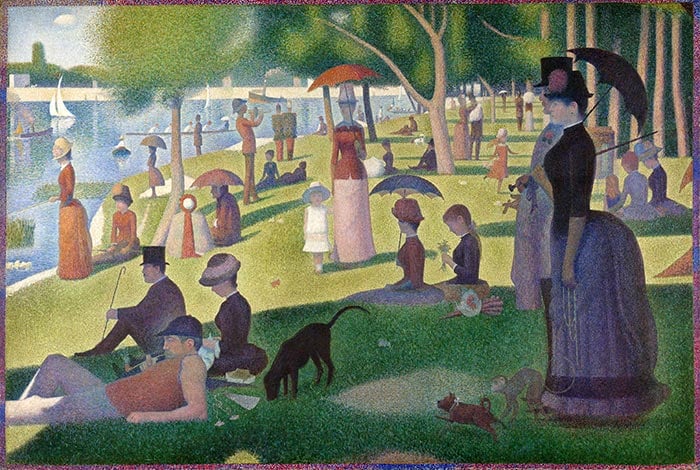
(Before diving into this post, make sure to pick up a copy of my free Landscape Painting Starter Kit.)
Key Facts
- It was painted between May 1884 and March 1886 and is one of Seurat’s larger paintings at 81.7 x 121.25 inches (207.6 × 308 cm).
- It is a great example of pointillism, which involves placing small dabs of distinct color and allowing our eyes to visually blend the colors together. His use of pointillism was an attempt to make his colors appear brighter and more vivid than what is possible from the physical mixing of paints. For example, instead of painting green by mixing yellow with blue, he would use small dabs of yellow, blue and green and let optical mixing do the rest of the work. But this comes at the compromise of delicate drawing, strong edges or skillful brushwork.
“Some say they see poetry in my paintings; I see only science.” Georges Seurat
- With this painting, Seurat was recognized as a figurehead of Post-Impressionism.
- In 1899, Seurat restretched the canvas to allow for a dark border of red, orange and blue dots. The idea was to emphasize the use of pointillism and contrast against the surrounding white frame (visible below).
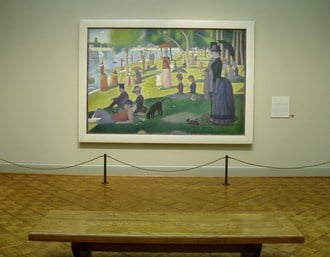
- For highlights of the grass, Seurat used a zinc chromate yellow which has been gradually turning brown due to a chemical reaction.
- It took over two years to complete, starting with numerous sketches and color studies of people in the park. Some of those studies are shown in the following section.
- Seurat’s Bathers at Asnières was painted just before A Sunday Afternoon. It features a view from the other side of the river. The bathers in this painting are part of the working class, whereas the baths in A Sunday Afternoon are bourgeoisie (middle class).
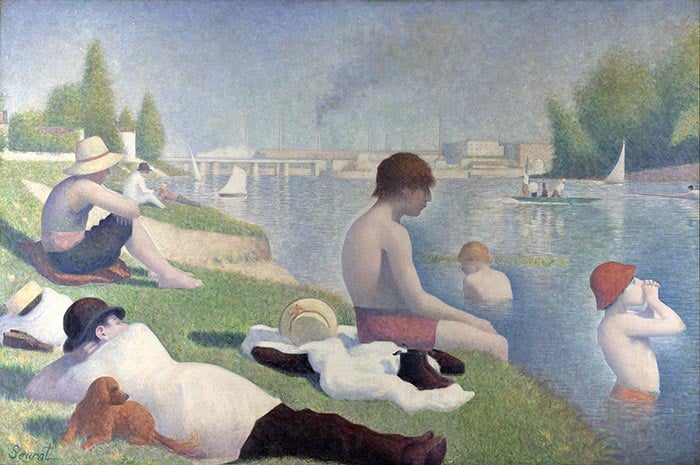
Sketches
Seurat created over 60 different sketches before painting A Sunday Afternoon. These studies provide insight into how Seurat worked through his initial idea and nurtured it into the finished painting. You can see him experiment with different compositions, color schemes and brushwork.
Here are just a few of his sketches:
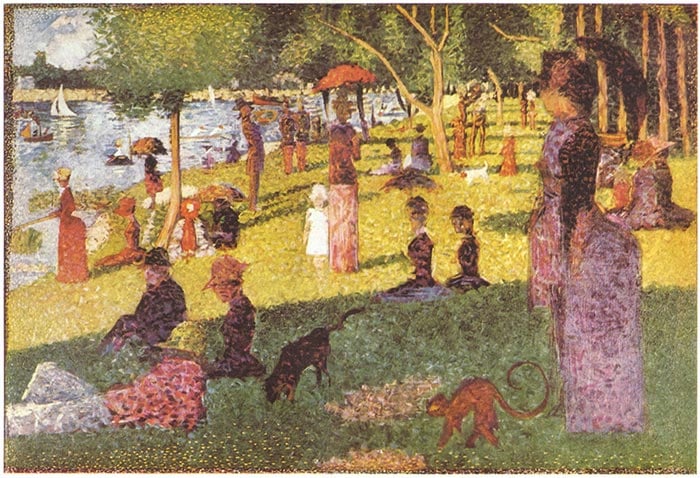
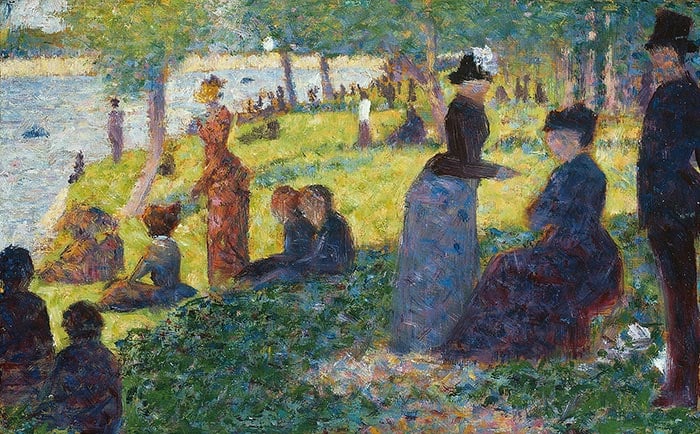
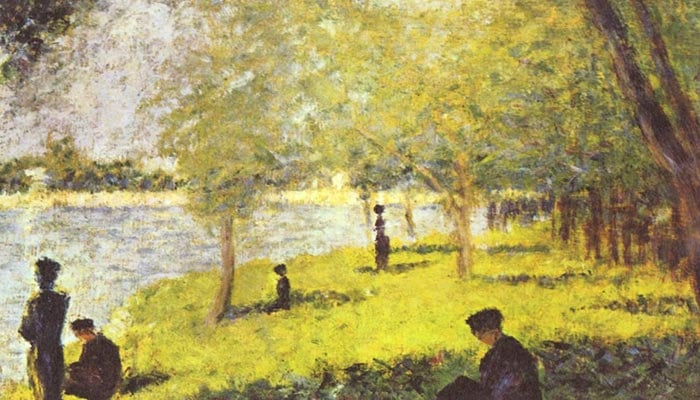
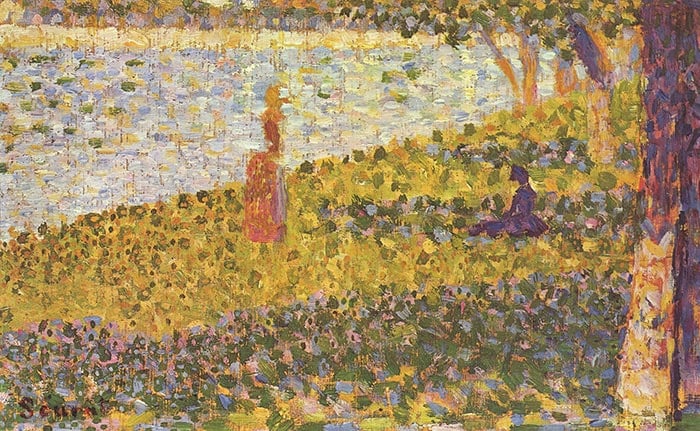
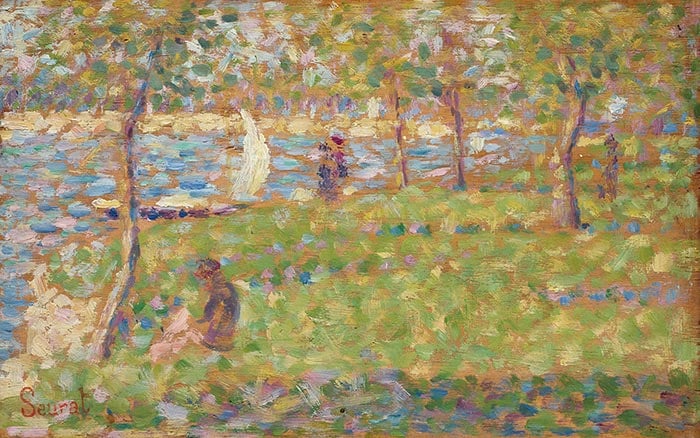
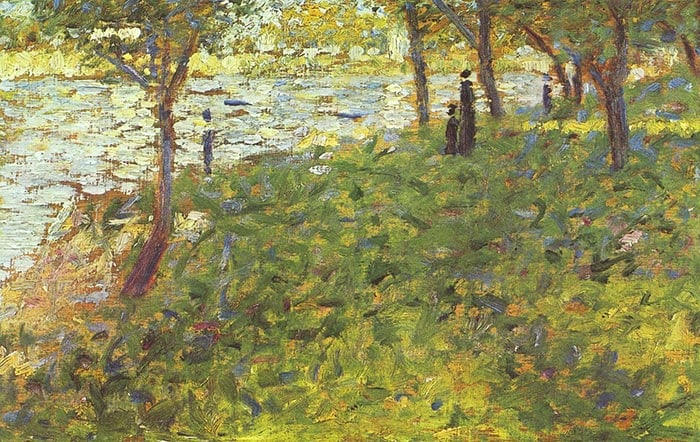
Tip: This should give you an idea of just how much work goes into master paintings. People tend to think the master paintings were created out of spontaneous creativity, but many times they are carefully planned.
Composition
It is a very busy painting, with many people, animals, boats and trees. Seurat did a great job balancing all these activities.
My first impression in terms of composition is that you can break the painting broadly into two parts – the dark foreground in shadow, and the background mostly in light. The edge of the main shadow acts as a strong horizontal line in the painting, which contrasts against the many verticles lines (the people standing or sitting firmly upright, trees and boat masts).
The people all appear very rigid to me, whereas nature is providing most of the curves (the curve in the river, the curve of the shadows, the curve of the tree branches).
There is a strong sense of linear perspective, with everything getting smaller as it recedes into the distance. Atmospheric perspective is not a strong feature, mostly because the background is hardly visible except for the small area at the top left corner.

Brushwork and Detail
Seurat did not use thick, impasto paint, but the lack of blending did leave a subtle texture from all the distinct dabs of paint. Close-ups of the painting reveal all the distinct colors he used, which optically blend together from afar.
The leaves are painted with greens, blues, yellows. The branches are painted with oranges, purples, yellows, blues and greens. Overlapping colors allow the branches to gradually blend in with the surrounding leaves.
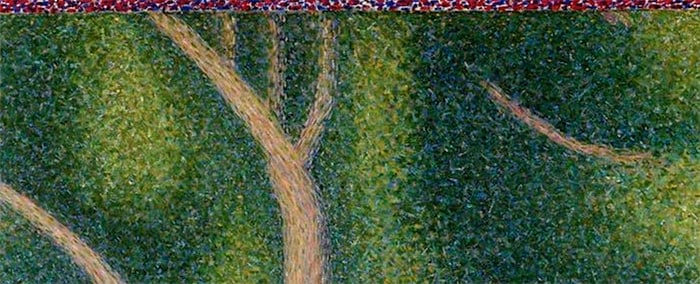
In the close-up below, you can see the border on the left side. Notice how Seurat used a vivid blue to continue the subject’s leg.
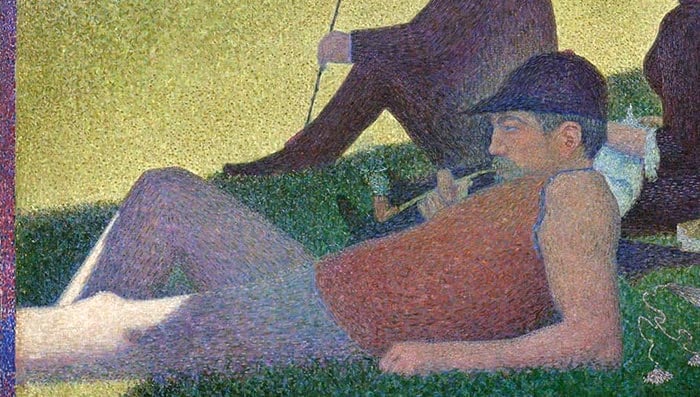
The main compromise of using a pointillist technique is the sacrifice it requires of intricate drawing and brushwork. This is most evident in the faces of the subjects; however, Seurat did a good job with rendering the subjects using just dots of paint.
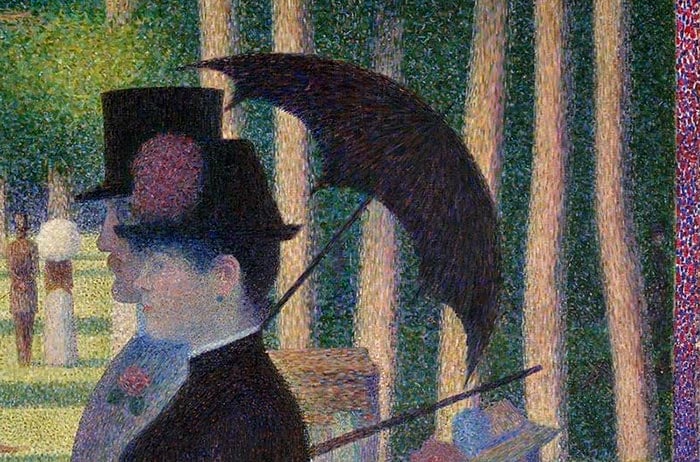
I find the pointillist technique to be great for painting a background of high-key colors like below. It tends to produce a glimmering effect as your eyes dance between all the light colors, similar to what you see in life.
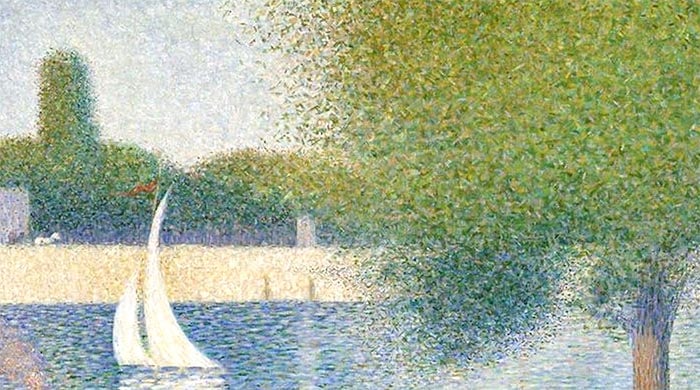
Key Takeaways
Here are some of the key takeaways from A Sunday Afternoon:
- If you want to make a mark in the art world, you should consider large-scale paintings like A Sunday Afternoon. They tend to have a much stronger impact than smaller works.
- The pointillist technique can be used to paint with brighter colors, but at the sacrifice of intricate drawing and brushwork.
- Great paintings take planning. Seurat created over 60 sketches before painting A Sunday Afternoon. If you are not satisfied with how your paintings are turning out, consider if you are putting enough planning into them.
Additional Readings
What You Can Learn From The Pointillism Art Movement
A Closer Look at Impression, Sunrise by Claude Monet
A Closer Look at the Mont Sainte-Victoire Series by Paul Cézanne
A Closer Look at The Oxbow by Thomas Cole
Want to Learn More?
You might be interested in my Painting Academy course. I’ll walk you through the time-tested fundamentals of painting. It’s perfect for absolute beginner to intermediate painters.
Thanks for Reading!
I appreciate you taking the time to read this post and I hope you found it helpful. Feel free to share it with friends.
Happy painting!
Dan Scott

Draw Paint Academy


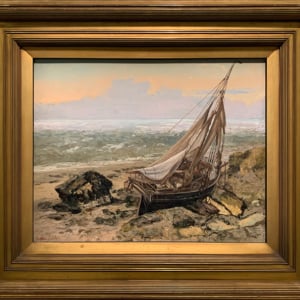
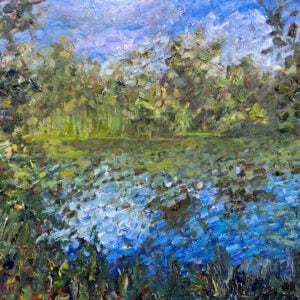
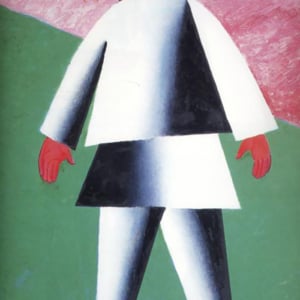
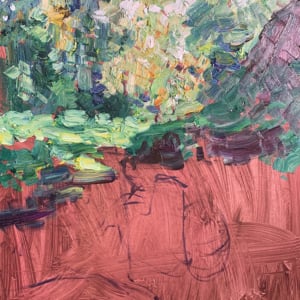
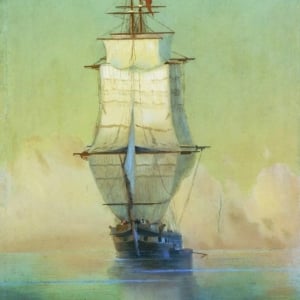
I like the way you discribe the painting for me. I learn a lot from your descibtion and it gives me an inspiration to paint.
Thank you.
Thanks for noticing and pointing out how the artist used a dark blue in the border to continue the man’s leg in shadow. Thanks for learning about and sharing the artist created sixty practice sketches!
No problem Holly. More to come! Dan
Happy to have helped Hilde. Thanks, Dan
Did you know that here in Columbus Ohio this painting is reproduced in topiary? It is something I take visitors to see since it is unique & no where else in the world. You can actually walk around “in” the painting
Very helpful!
Thanks for such an interesting article. It really makes me want to try something similar, but a lot smaller!!
Sounds great John! Let me know how you go. Dan
I really enjoy your posts.
Glad to hear this Muareen! Thanks, Dan
Thanks so much for sharing this work. It’s totally awesome. Makes me want to try this.
Definitely give it a go Deborah! All the best. Dan
Wow! 60 sketches before the final piece! Thanks for posting- very informative!
More to come Shari. Dan
A very interesting and informative piece – thank you.
Thanks Christine. Dan
I’m fascinated by the way you can pick out the details of a painting and the history behind it! I never would have considered pointillism, but like John said at a much smaller size. Thank you.
No problem Ruthann. Glad you enjoyed it. Dan
I found your points on pointillism spot on! This is one of my childhood faves..I always thought there was a hidden joke in this painting, whose reproduction hung on my preschool bedroom wall. The woman with the ‘hooped out’ skirt!? There’s a monkey under it, but I couldn’t figure out why he didn’t put in the tail!?
I guessed that was precisely the ‘underlying’ joke of the painting, and that’s why I loved it so!
I have to say way back in my early art school years I was not as interested in art history. Too bad because now that I am retired I see the tremendous value of studies of the masters. I truly enjoy reading your posts. Glad I stumbled on to your website. I paint in watercolor but still lots to learn in your comments. Thank you for this effort of enlightenment! God bless.
Glad to hear Margo! Yes, a lot of the information I put out is about the fundamentals so even though you paint in watercolor, a lot of the information you can still apply to your paintings. Thanks Margo! Dan.
Dan, thank you for sharing your wonderful, detailed analysis of this painting. Since I joined your group I have learned more about art than I ever guessed I’d learn. Thanks again!!!
Great to hear Joan! I am just happy to help. Dan
Thanks Dan! I enjoy your articles.
Thanks Anne!
Thank you for. Your interesting article.
Thankyou, I always learn something from your posts.
Glad to hear Jean! Thanks, Dan
Thanks for sharing. As an older senior I
enjoy your posts as we were never exposed to art. Life was different, so now I love anything
Available.
I
Happy to be able to help Frances.
Thank you, Dan. I enjoy your posts and am learning a lot from them.
Glad to hear Sharron! Dan
This morning I had the opportunity to read this excellent overview of this Seuret painting. This afternoon I visited the Art Institute of Chicago. To my surprise there was the Seuret painting, Sunday Afternoon on the Island of La Grande Jette. I was able to share with my husband the wonderful information provided in your presentation. What an amazing coincidence. Thank you for your most enjoyable and educational presentations.
I am jealous Renee! I have not had the privilege of seeing it in person… yet. Glad you enjoyed the post. Thanks! Dan
Thank you very much for your helpful and educational, brilliant little articles!! I look forward to each and every one. Someday , soon, my intentions are to take your classes…I love what you do. Please keep providing us with these greatly inspirational teachings!!
Thanks for your kind words! Definitely more to come. Dan
Have you ever seen the topiary garden at the old school for the deaf in Columbus, Ohio? It recreates this painting and is was quite impressive seeing it mature and change from 1996 to 2002. The sculptor was addressing the saying does art imitate life or does life imitate art.
You provide informative analysis and description. What painstaking effort to plan, practice and produce paintings like these.
Thanks Willem. Dan
Just beautiful!. I am very glad to follow you and really appreciate your efforts for all tips you share with us Thanks a lot!
Thanks Maria! Happy to help. Thanks, Dan